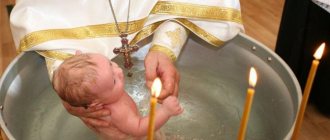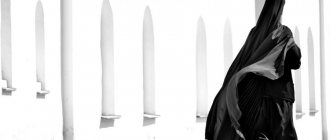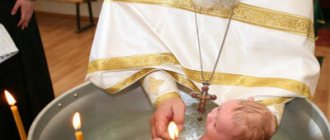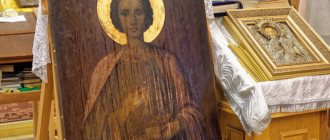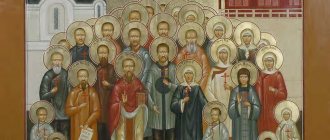Myrrh-streaming
- a phenomenon in Christianity associated with the appearance of oily moisture (the so-called myrrh [1]) on icons and relics of saints.
The phenomenon represents the appearance on the icon of a light, oily substance emitting a fragrance. Different cases of myrrh-streaming differ from each other in the appearance, color and consistency of the liquid that appears. It can be thick and viscous, like resin, or resemble dew (in this case, myrrh flow is sometimes called “ unction
” or “
dew flow
”).[2]
For some believers, the flow of myrrh is one of the miracles, but discussions about the causes and nature of this phenomenon are ongoing among theologians.[3]
A scientific objective study of the phenomenon of myrrh-streaming is hampered by the fact that the commission[4] “ is not allowed to conduct experiments on holy icons recognized in Russia
».
Content
- 1 History of myrrh-streaming
- 2 Theological explanation of the phenomenon 2.1 Church reaction to the facts of mass myrrh flow
- 2.2 Procedure for establishing myrrh flow
- 3.1 Fraud 3.1.1 Forensics
- 3.2.1 Applying oil by contact
Clergy Focuses
There is a well-known incident that occurred during the reign of Peter I. As is known, in those days many revolutionary laws were adopted that significantly changed the way of life of society, which, of course, many priests did not like. And then one day in one of the cathedrals the icon of the Mother of God began to “cry”. The priests immediately hastened to declare that she was mourning the old order being destroyed by Peter. And although Peter was a believer, he was not particularly impressed by what was happening. Moreover, he sent a letter to the rector of this cathedral, in which he promised that if such a “miracle” happened again, then the blood would come from the “asses” of the priests. Surprisingly, after this, not one of the icons during the reign of Peter I ever “cryed.” Many, of course, wonder how the “miracle workers” manage to perform such tricks? In fact, everything is very simple. All that needs to be done for this is to make small channels on the back of the icon. Next, behind the icon, special vessels are placed with blood, vegetable oil or any other liquid, which, when passing through the channel, will seep onto the front of the icon and then roll down it like a tear. For this reason, ordinary water is never poured into the vessels, since it will not be able to flow down the icon in the form of a natural teardrop.
History of myrrh-streaming
The Holy Scriptures do not say anything about the flow of myrrh; all references to this phenomenon are contained only in the Holy Tradition. The earliest reports of myrrh streaming include:[5]
- fragrant myrrh from the tomb of the Apostle John the Theologian, which came out annually;
- the myrrh-streaming of the relics of the Apostle Philip (according to the apocrypha “ The Acts of the Apostle Philip
”, a monument of the 2nd-3rd centuries); - “The Martyrdom of Theodotus of Ancyra” (III century) reports the expiration of the world from the remains of the martyr;
- numerous reports of abundant myrrh-streaming of the relics of Demetrius of Thessaloniki (Dimitri of Rostov reports that the myrrh-streaming has been known since the 7th century[6], but John Skylitzes was the first to write in writing that the myrrh-streaming first appeared in 1040[7]);
- relics of St. Nicholas the Wonderworker, located since May 9, 1087 in the crypt of the saint's basilica in the city of Bari (Italy), constantly exude myrrh, which is removed annually by the priests through a small hole in the lid of the tomb.[8]
- flow of oil from the relics of St. Theodora in Thessalonica around the 14th-15th centuries. “Myrrh constantly flows from her, like from a flowing source, from the left leg into the basin.
A year has passed, and the ports are removed from her, soaked as if in oil. This myrrh is distributed to devout Christians for blessing, and new ports are put on it” [9].
Modern examples:
- According to numerous testimonies, the Montreal Iveron Icon of the Mother of God flowed myrrh almost continuously for 15 years (1982-1997).
- In 2009, during a service in a military unit in Sevastopol, the icon of the Mother of God “Softening Evil Hearts” was filled with blood[10].
How to treat myrrh streaming
How do believers feel about the fact that the icon has become myrrhized? What it is? Many people treat it with reverence; for them such a phenomenon is another sign of God’s grace. Others view this phenomenon in a consumerist, perhaps even occult way. They hope that this very ointment will help them heal from an illness or achieve another goal. Still others approach this issue with curiosity, but with some detachment.
What is the correct attitude if an icon is streaming myrrh in a house or church? What does it mean? The main thing is caution. Don't rush to conclusions. It is known that the devil can also perform miracles. Outwardly, they look the same as manifestations from God, but their consequences can be very sad and lead to the destruction of the soul. A simple example: owners of myrrh-streaming icons often begin to suffer from vanity and then pride.
In addition, the holy fathers argue that one should not strive for a miracle. Our faith must be strong in itself, regardless of whether we come into contact with a miraculous phenomenon or not. Caution in case of myrrh streaming is the best way out.
Theological explanation of the phenomenon
All canonical icons in churches or homes are sacred due to their spiritual content and meaning. However, some are chosen by God's Providence for special signs. The indescribable light, fragrance, and myrrh emanating from them are material signs of the appearance of the heavenly world, the Kingdom of God[11].
Pavel Florensky, a member of the commission for describing miraculous signs in the Russian Orthodox Church, believes: “There is no need to focus too much on the miracle of myrrh flowing - well, it is there, and thank God. Moreover, there is a danger that someone wants to become famous and pretends to be a miracle. Well, okay! Even the fact that there is such a fool who does this is also a miracle for the glory of God!”[12]. He claims that “the icons recognized and revered in Rus' have never flowed myrrh. Only new icons and those that stand in private homes “cry”[4].
In the “Complete Church Slavonic Dictionary” by G. Dyachenko it is said that the epithet “myrrh-streaming” means “exuding miraculous myrrh for the healing of diseases”[13]. However, the flow of myrrh in itself is not a fact on the basis of which an icon is considered miraculous. The myrrh itself exuded by the icon or relics is considered miraculous. A typical example of peace from the relics of Demetrius of Thessaloniki is John Anagnost, who described the capture by the Turks of the city of Thessaloniki, where the relics of the saint are kept, and reports that even Muslims collected myrrh, who considered it a medical drug for any disease[14].
Church reaction to the facts of mass myrrh streaming
Modern theologians call for a sober attitude towards the facts of myrrh flow. Thus, Andrey Kuraev writes:
Even pagan statues streamed myrrh. Icons stream myrrh in the most terrible sect called “Theotokos”). Therefore, in itself, bleeding, tearing, or myrrh-streaming is not an argument for the holiness of a particular image, especially a character[15].
Metropolitan Nicholas of Nizhny Novgorod and Arzamas answered the question about the myrrh-streaming of icons:
I don't have any myrrh flowing. If we want to suck something out of our fingers, we will suck it out. There should be a certain commission that should study such things. And all this was left to chance, carelessly. They announced the myrrh-streaming, and everyone was silent. We have a parish in the Bogorodsky district. Suddenly there was a huge uproar: 68 icons had lost their myrrh! I grabbed my head. Guys, you need to have some kind of conscience! A commission was quickly created. All icons have been wiped clean. The temple was sealed and closed. It stood for a week. At least one drop appeared. So I approach this with a certain caution[16].
The procedure for establishing myrrh flow
Due to numerous dubious facts about the appearance of the world on icons, the Russian Orthodox Church has established a special procedure for a commission examination of the myrrh flow. When a leak of peace is discovered on an icon, this fact is reported to the diocesan administration, which sends a special commission to the church. Its functions include interviewing witnesses and examining the icon (its location, storage conditions). If the conclusion is positive, a new commission is sent to more thoroughly investigate the possibility of oil stains appearing naturally.
If the second commission did not reveal signs of the natural origin of myrrh-streaming, then the icon is placed in a sealed icon case. If oily stains continue to appear in it, then the icon is declared myrrh-streaming[17].
In the “Moscow Diocesan Gazette” of 2005, an analysis of the facts of mass myrrh-streaming of icons in the house of V. M. Zhuchkova in Klin reported:
Speaking about the genuine phenomena of myrrh flow from icons, the following should be said:
- myrrh-streaming from icons was never associated only with a specific place, but icons streamed myrrh in different places;
- never have genuine myrrh-streaming been associated with the presence of a specific living person;
- the real myrrh-streaming never stopped if the icon was brought to the temple[18].
Myrrh-streaming icons
Icons can contain not only bloody tears or streams, but also colorless liquid. In this case, they say that she is “crying.” The liquid may indeed be clear and very similar to ordinary tears. In some cases, it is fragrant and resembles myrrh. Sometimes she doesn't smell like anything.
Myrrh streaming cannot be explained by any logical argument, because there is no definite pattern. This phenomenon occurs with both new and old icons. They can be in a person’s home or in some kind of temple. Even a copy of an icon can begin to bleed or smell fragrant. Tears in some images can go against all physical laws - from bottom to top or along a horizontal line.
It is believed that the flow of myrrh is a way for higher powers to give a sign to humanity. It is important to interpret it correctly. When the tears of icons are fragrant, they prefer the version that positive changes are coming.
Until the 20th century, historians recorded only 6 facts when icons streamed myrrh. After this milestone, the phenomenon began to occur more often, and it was noticed that the process begins on fasting days.
In any case, myrrh-streaming or bleeding is treated with caution. Some people want to get the liquid for treatment, considering it miraculous, while others use it for profit. True myrrh-streaming must be treated as a grace given by God, without showing consumer qualities.
Subject:
- Orthodoxy
Rational explanation of the nature of the phenomenon
Several factors have been identified that determine the occurrence of “myrrh-streaming”:
Fraud
There is a known case of public exposure by Emperor Peter the Great of artificial myrrh-streaming[19]:
“His Majesty soon found very small and almost completely inconspicuous holes in the eyes of the image, which the shadow cast in that place made even more inconspicuous. He turned the board around, tore off the frame, and having broken out the crossbar or connection, which usually happens with images on the other side, to his pleasure he saw the truth of his guess and discovered the deception and the source of tears; namely: holes were made in the board opposite the eyes of the image, in which several thick wooden oils were placed, and which were covered with a back crossbar. “Here is the source of wonderful tears!” said the Emperor. Each of those present had to come and see this cunning deception with their own eyes.
Then the wise Monarch explained to those around him how the thickened oil, closed from everywhere, could last so long in a cold place, and how it flowed into the aforementioned holes in the eyes of the image like tears, melting from the warmth, when the place against which it lay was heated by the candles , lit in front of the image."
This story received a legendary[20] continuation in the form of a fictitious order from Peter I: “ Holy Lords! I order that the Mother of God not cry from now on. And if the Mother of God cries with lamp oil at least once more, then the priests’ backsides will cry with blood
».[21]
Forensic examination
The head of the expert group on miracles at the Synodal Biblical-Theological Commission of the Russian Orthodox Church, Pavel Florensky, in an interview in 2004 about the work of the commission to describe miraculous signs in the Russian Orthodox Church, said that when examining samples of substances taken from various icons, experts from the FSB Institute of Forensic Sciences made a conclusion : “...the composition of the substance from the surface of the icon is identical to flavored sunflower oil...”[4]. At the same time, he noted that the commission “is not allowed to conduct experiments on holy icons recognized in Rus'.”
The natural process of moisture formation under specific conditions.
Applying oil by contact
Traces of oil, which is used to anoint believers on polyeleos (after anointing, a person, having kissed the icon, leaves drops of oil on it).
Oil vapor condensation
The icons may get oil from the lamps hanging in front of them.
In Toronto in 1996, a mass pilgrimage to the icon of the Mother of God, declared myrrh-streaming, began. Joe Nickell from the Society of Skeptics (USA), at the invitation of the Toronto Sun newspaper, examined the icon and concluded that the oily stains on its surface came from lamp oil from the lamp hanging in front of it[22].
Capillary effect
On March 10, 2012, Indian rationalist and skeptic Sanal Edamaruku flew to Mumbai. TV9 Maharashtraruen invited him to investigate the “miracle of myrrh flowing” from the feet of the statue of Christ, which caused a local stir.
He and the film crew went to the Irla area of Vile Parle, a suburb of Mumbai, to view the crucifix standing in front of the Church of Our Lady of Velankanni. This crucifix became the center of attraction for a growing crowd of believers arriving from far and wide. The news of the miracle spread like wildfire: for several days small drops of water flowed from Jesus’ feet. Every day hundreds of people came to pray and collect some “holy water” in bottles and other containers. Irla turned into a center of pilgrimage.
But thanks to Sanal Edamaruku this did not happen. Within minutes, he clearly identified the source of the water (a leaking sewer pipe in a nearby laundry room) and the mechanism by which the water reached Jesus' feet (capillary effect). Local church leaders present at the investigation were far from pleased.[23]
Bleeding Derzhavinskaya Icon of the Savior photo of a bleeding lithographic icon of the Savior, a brief history
PRAYER
in front of Bleeding Derzhavinskaya
icon of the Savior
Lord Jesus Christ, who suffered crucifixion on the cross of Calvary, who shed your venerable blood for the salvation of the human race in unspeakable torment, and now from your holy icon in the village of Derzhavino you pour out your blood abundantly for us. Let this bleeding from Your icon be not a condemnation for us, but a sign of God’s Mercy, a call to repentance and correction. May the stony insensibility of our hearts be softened by the contemplation of the great and terrible mystery of Your Holy Blood flowing from Your Face on the icon. Let this sign be: for the faithful in affirmation and application of spiritual strength, for the faint-hearted in faith strengthening, for those who have fallen away to return, for those who do not love You with love for God and for their neighbors in ignition, for Our Earth in the promise of reconciliation with God and deliverance from the yoke of godlessness.
Lord Jesus Christ! The Angels could not look at Your Holy Blood, which flowed out on Golgotha, without fear and trembling: The Sun knew its west and darkened at that hour when You shed Your Blood for us on the Cross, and the earth’s firmament shook like the sea, unable to withstand the weight of the drops Your priceless Blood. Do not allow us, sinners, to look at Your Blood flowing from Your Face on the icon without fear and horror and trembling of heart. We, inexorable servants, cry out before Your icon: forgive us, for our sins and iniquities again and again crucify You, our Savior. As You prayed to the Father for Your tormentors on the Cross of Calvary, saying: “They know not what they are doing,” so forgive us, who crucify You with our passions and lusts, but forgive You before the holy icon of those who ask, and give our souls salvation, and the State Russian in the sin of deviation from the Holy Orthodox Faith, repentance and forgiveness and deliverance from troubles. And may Thy mercy, Thy Father and the Holy Spirit, be upon us. Amen.
BRIEF INFORMATION ABOUT THE ICON
The first miraculous phenomenon (the image of the Lord began to smell strongly and flow myrrh) began on May 5, 1999. The owners of the icon, 68-year-old Antonina Vladimirovna Efimova and her daughter, 33-year-old Olga Vladimirovna Efimova from the village of Derzhavino, Buzuluksky district, Orenburg region, immediately noticed this reported what they saw to the clergy. The news of the myrrh-streaming quickly spread throughout the Volga region and the Urals, and pilgrims flocked to the house. The icon began to be invited to different parishes.
Olga Efimova, who from that time became the keeper of the miraculous image, began to take it for prayerful worship to parishes and monasteries of different dioceses of Russia. Some icons, after they were placed next to the miraculous icon, themselves began to stream myrrh.
On April 5, 2000, on Great Wednesday, small spots of red liquid suddenly began to appear on the surface of the icon (on the face and blessing right hand, and then on the forehead), which behaved like blood: it thickened, coagulated and turned into scabs. The Efimovs' house smelled of blood. Having learned about this wonderful and terrible phenomenon, the Samara clergy immediately organized an appropriate biochemical examination, which confirmed the Orthodox - the icon miraculously secretes real human blood. Hematologists even established the blood group - IV, which coincided with the data obtained by their Italian colleagues who examined the bruises of the Shroud of Turin. Meanwhile, the blood stains, which at first were small and barely noticeable, quickly dried out and thickened, began to increase in size, dry more slowly, and the scabs that formed in their place began to stay on the board longer than before.
As often happens in such cases, the miraculous nature of the image is confirmed by its healing properties. In a year and a half, the icon visited more than half of the dioceses of Russia and other CIS countries. And everywhere many sick people prayerfully resorted to the miraculous image, and many healings were recorded.
On October 6, 2011, a great event took place in the spiritual life of Orthodox Ukraine. The miraculous, bleeding image of the Lord Jesus Christ has arrived, and will now remain forever in Ukraine. The miraculous icon of the “Bleeding Savior” is located in the convent of the Athos Icon of the Mother of God in the Kipyachee tract in the village of Chopovichi, Zhitomir region, Korosten district. The famous icon, with the blessing of the head of the Ovrutsk diocese, Metropolitan Vissarion, was transported from the Belarusian Brest to the Zhitomir region by the abbess of the Monastery of the Athos Icon of the Mother of God, Abbess Ekaterina (Smychok), and the guardian of the bleeding image of the Savior, the former head of the State Land Committee of Ukraine, Oleg Nikolaevich Kulinich.
In the village of Chopovichi, the bleeding image was met by the diocese manager, Metropolitan Vissarion of Ovrutsk and Korosten, the clergy of Ovrutsk and other dioceses, the nuns of the convent of the Kipyachee tract, the men's community of the monastery of St. Silouan of Athos under construction, People's Deputy of Ukraine from the People's Party Nikolai Rudchenko, as well as believers and pilgrims.
In the monastery of the Athos Icon of the Mother of God, a prayer service with an akathist and anointing was served before the miraculous image of the Lord. The prayer singing was led by Metropolitan Vissarion and a host of clergy. After the prayer service, the bishop addressed those present with a sermon. In his archpastoral speech, the Metropolitan spoke about the great event of finding in the monastery of the diocese the miraculous image of the Savior Lord Jesus Christ, as a living testimony in our time to the Savior’s sacrifice on the cross, His living presence in our lives and the destinies of the world, as a miracle calling to repentance.
This event became possible thanks to the spiritual will of the caretaker of the bleeding image, nun Angelina (Efimova). As it became known from the text of the spiritual will and the words of her own daughter Olga Efimova, back in 2004, when the icon was brought to Ukraine, sister of mercy Nadezhda Smychok was blessed to look after the caretaker of the icon, nun Angelina. Touched by the care of the sisters of mercy, nun Angelina decided to convey the miraculous image of the reviving monastery in the village of Chopovichi. And later, when she learned that Sister Nadezhda had become Abbess Catherine, she bequeathed the image to her personally.
After the death of Mother Angelina, the image was kept in the custody of her own daughter Olga Efimova for two years.
The bleeding icon of Christ the Savior from the village of Derzhavino, Orenburg region (Russia), initially smelled strongly and flowed abundantly with myrrh in the second half of 1999. On April 5, 2000, worshipers noticed that a pale pink liquid, reminiscent of ichor, appeared from the blessing right hand of the Savior. Soon blood flowed from the opened wound. After some time, red dots swelled in the Lord’s hair - like marks from a crown of thorns - and streams of blood flowed from them. Merging with the streams of the world, they became bright scarlet. And on the wounds themselves, dark brown crusts formed, as always happens with dried blood. At this time, a photograph was taken, a copy of the icon, from which people also receive healing from mental and physical ailments. The gauze placed under the icon was also stained with the blood of the Savior, as evidenced by the theological commission and many bishops in Russia, Ukraine and Belarus.
Over the course of 10 years, the shrine visited Russia, Belarus, Ukraine, Moldova, Romania, Hungary, and Serbia. She was received by Bishop Mark in Berlin. The icon was in Bulgaria and Turkey. Bishop Vladimir met her at the Pochaev Lavra. In Chernivtsi she was met by Metropolitan Onuphry of Bukovina and Chernivtsi, who also composed the prayer. The holy image was met by Metropolitan Philaret in Minsk. Metropolitan Philotheus of Greece, speaking on television, showed a photograph of a miraculous image with a call to repentance and purification of faith.
https://pravoslavye.org.ua/201…
Notes
- It should be distinguished from the world, which is brewed in every local Orthodox Church and is used to perform the sacrament of confirmation.
- Grishechkina N.V. Renewal and myrrh-streaming of icons (chapter from the book “Miraculous Icons in Rus'”)
- Florensky P.V., Moskovsky A.V., Soshinsky S.A., Shutova T.A. Test by miracle? // Miracles, true and false. M. 2008. pp. 11-36 ISBN 978-5-89101-269-1
- ↑ 123
Pavel Florensky: “Myrrh-streaming icons “work” like nuclear power plants” - About the myrrh-streaming of holy relics
- The Suffering and Miracles of the Holy Glorious Great Martyr Demetrius
- Charalambos Bakirtzis Pilgrimage to Thessalonike: The Tomb of St.
Demetrios // Dumbarton Oaks Papers, Vol. 56. (2002), p 176. - Official website of the Basilica of St. Nicholas (English) (inaccessible link). Access date: January 17, 2010. Archived September 22, 2013. (English)
- ZOSIMA'S WALK TO TSARGRAD, ATHOS AND PALESTINE (The journey and events of the sinful monk Zosima, deacon of the Sergius Monastery.) 1419-1422 // Book of Walks. Notes of Russian travelers of the XI-XV centuries. - Moscow: Soviet Russia, 1984. - P. 305. - 448 p.
- During a service in Sevastopol, the icon was filled with blood.
- Lyubomudrov A. A.
Myrrh-streaming and crying of icons. - Myrrh-streaming: why do icons cry?
- Dyachenko G., priest.
Complete Church Slavonic dictionary. - M., 1900. - P. 325. - Bakirtzis C.
Pilgrimage to Thessalonike: The Tomb of St. Demetrios // Dumbarton Oaks Papers. - Vol. 56. - 2002. - P. 187. - Deacon Andrey Kuraev
. Church in the world of people. Archived copy from February 1, 2009 on the Wayback Machine - About the authorities and the Church of Christ (interview with Metropolitan Nikolai (Kutepov))
- The order is given according to V. Sokolov, deacon.
About the flow of myrrh, real and imaginary. - Boris Balashov, archpriest.
On the churchliness of miracles // Moscow Diocesan Gazette. - 2005. - No. 3-4. - Acts of Peter the Great, the wise transformer of Russia; collected from reliable sources and arranged by year. M., 1789. Part VII. pp. 93-97.
- Basov D. The miracle of myrrh flow. St. Petersburg, 2001. ISBN 5-88801-240-8. P. 40
- Quoted from Duluman E.K. Myrrhflow - Nonsense on vegetable oil
- Anomaly No. 16 (148), September 1, 1997 (based on materials from the Skeptical Inquirer magazine, No. 2, 1997) (Russian) (inaccessible link). Access date: February 1, 2009. Archived October 10, 2006.
- Sanal Edamaruku under threat after Catholic 'miracle' revealed
What to do with crying icons, bleeding crosses and other miracles
From time to time, news headlines include reports of tears, drops of blood, which most often appear on icons or other religious objects. There are different names for this phenomenon: myrrh-streaming, dew-streaming, oil-streaming, bleeding, etc.
What is this and how to treat such cases, read on.
Lev Belov, pastor of the Light of the World Church, Tutaev (Russia)
No attitude at all, let those who want to live in a beautiful deception continue to do so. You live in the presence of God, seek His face, meet Him, and seekers of miracles will come to the place where you have already been, because the Presence of God was there.
I live in the heart of the “Golden Ring” of Russia and have seen enough eccentricities. People want miracles, and they look for these supernatural manifestations, which is why they get caught. When a person does not know God, he looks for His manifestations, looking for at least something that would testify about God. But God is simple and brilliant in His simplicity. God once created a real miracle - the world around us! A world, admiring which we never cease to be amazed at this miracle, and it is a miracle! But seekers of miracles do not see the obvious behind the simple. In their search for God's presence, they lose sight of God himself. God gave the most faithful prophetic word - the pure in heart will see God!
Archbishop Sergei Zhuravlev, Reformed Orthodox Church of Christ the Savior ROCHS, Kiev Archdiocese
On the topic of “myrrh-streaming, “tear-bleeding” and “bleeding” of all kinds of idols - religious and political... “Bloody” Nicholas II “streamed myrrh” the other day... “Myrrh-streaming”, “bleeding” and “tear-bleeding” icons in churches... Cult of the so-called . “miraculous” icons are an example of complete idolatry in our Orthodoxy, alas. Idolatry is in the blood of fallen man and only a new spiritual rebirth, rebirth from God and the Gospel, Biblical rethinking of all things - salvation from idols.
Bishop of Trinity Pankratiy, abbot of Valaam Monastery
I think that in cases of myrrh streaming or other similar unusual phenomena associated with the Church, contemptuous mockery or, on the contrary, enthusiastic exaltation is completely inappropriate. Of course, careful verification of these phenomena is required. But before official confirmation or refutation, we must follow the wise advice of the holy fathers: do not accept and do not reject... The Lord Himself will show us the truth if it pleases Him.
From the book by Valery Tatarkin “Returning to the Origins of Christian Doctrine”
The origin of the “tears” on some icons remains a mystery. However, reliably known facts should give sane believers pause. In Rus', the first mention of the myrrh-streaming icon, according to various sources, dates back to the 11th - 18th centuries. Before this, for some reason, the icons did not cry. Afterwards - relatively rarely. And at the end of the 20th century, the icons began to tear more abundantly. At first these were isolated cases that were enthusiastically received by believers. Accordingly, pilgrims immediately gravitated towards miracles. Then the number of tearful shrines began to increase. And after that, dozens of icons burst into tears, not only wooden ones, but also plastic ones and even reproductions, photographs and photocopies, moreover, not consecrated in the church. It is already known for certain that moisture appears from above, and does not come from inside icons and other “holy” objects, which means that it may well be artificially applied there or physical processes for its condensation are caused using chemistry. History even knows the fact that such a miracle was fabricated directly by the church. The man-made nature of myrrh-streaming was exposed by Peter the Great. He tore off the frame from the weeping icon and saw on the other side of the board near the eyes a thick wood oil specially placed there, which began to flow out of the holes, heating up from the burning candles. Afterwards, as described in “The Acts of Peter the Great, the Wise Transformer of Russia” (Part 7), he told those present:
“Now you have all seen the reason for the imaginary tears. I have no doubt that you will talk everywhere about what you have seen with your own eyes; this will serve to prove the emptiness and refute the stupid, and perhaps even malicious, interpretation of this false miracle.”
Metropolitan Hilarion of Volokolamsk
First of all, it should be said that myrrh streaming is an irrefutable, repeatedly recorded fact that cannot be questioned. But a fact is one thing, its interpretation is another.
When the myrrh-streaming of icons is seen as a sign of the onset of apocalyptic times and the imminence of the coming of the Antichrist, then this is nothing more than a private opinion that in no way follows from the essence of the very phenomenon of myrrh-streaming.
I think that the streaming of myrrh from icons is not a gloomy omen of future disasters, but, on the contrary, a manifestation of God’s mercy, sent to comfort and spiritually strengthen believers. An icon exuding myrrh is evidence of the real presence in the Church of the one depicted on it: it testifies to the closeness of God, His Most Pure Mother and the saints to us.
Theological interpretation of the phenomenon of myrrh-streaming requires special spiritual wisdom and sobriety.
Excitement, hysteria or panic around this phenomenon is inappropriate and harms the Church. The pursuit of a “miracle for the sake of a miracle” has never been characteristic of true Christians. Christ himself refused to give the Jews a “sign,” emphasizing that the only true sign was His own descent into the grave and Resurrection.
Pastor Igor Shemigon, Evangelical Lutheran Church of St. Martin, Kyiv (Ukraine)
Myrrh-streaming is the appearance of fragrant moisture, and in some cases blood, on icons, statues, and relics of saints. It is observed not only in historical churches, but also in pagan religions and some parachurch movements. It causes a special stir in popular Orthodoxy/Catholicism. Thus, Natalia Poklonskaya’s statement about the allegedly myrrh-streaming bust of Nicholas II was recently actively discussed on social networks.
When tested, most cases of myrrh-streaming turn out to be falsifications in order to attract gullible pilgrims. There are cases of natural occurrence of oily moisture on relics. For example, from people kissing icons after the rite of anointing or when oil appeared there from lamps hanging nearby. In order to figure out whether the case of myrrh-streaming is supernatural or whether we are talking about a completely man-made miracle, special commissions operate at historical churches. It is based on the results of their activities that we come to the conclusion that most of these cases are not a miracle from above.
Are there cases of myrrh streaming that can be called miracles from God? Haven't seen it yet. And therefore I cannot definitely call this phenomenon evil. After all, the Lord can do whatever He pleases. But as a Lutheran Christian, I am very confused by the absence of such cases in the Holy Scriptures. If the flow of myrrh was an important evidence of the truth of faith and through it God showed His grace, then He would have recorded this in His Word. But you won’t find it there by any chance. Moreover, from it we know that excessive emphasis on the veneration of relics leads away from the Lord, being a form of idolatry. It is not normal when people come in crowds to kiss a strange thing or to so-called healing sessions, but not to the liturgy, where the greatest of miracles takes place - the birth of faith.
Head of the working group for the study of miraculous phenomena Pavel Florensky
The appearance of oil on various revered objects is a very common phenomenon in many faiths, including shamanism. It's better to take it calmly. The commission and I are very concerned that this miracle has appeared.
INVICTORY is now on Youtube, Instagram and Telegram!
Want the best content delivered straight to your favorite platforms? We prepare for you reviews of new films, interesting podcasts, breaking news and useful tips from ministers on popular platforms. Many materials are published only on them, without even getting to the site! Subscribe and be the first to receive the most interesting information!
Why do icons stream myrrh and cry in churches and at home: folk signs
Interpretations will accept:
- The icon “cries” is a sign that foreshadows changes in the future; if the “tears” are light, they will be good, if dark, they will be bad.
- The icon was covered with “dew” - a good sign that tells you that everything will be fine.
- The icon streams myrrh abundantly - a good sign of approaching favorable events.
- The icon streams myrrh in the church - a favorable sign for the church, city, and parishioners.
- The icon streams myrrh at home - a good event will happen in the family
